Vermont Stonework Artist Thea Alvin
Thea Alvin is known around the world for her gravity-defying stonework, but her art begins in her own rural Vermont backyard.
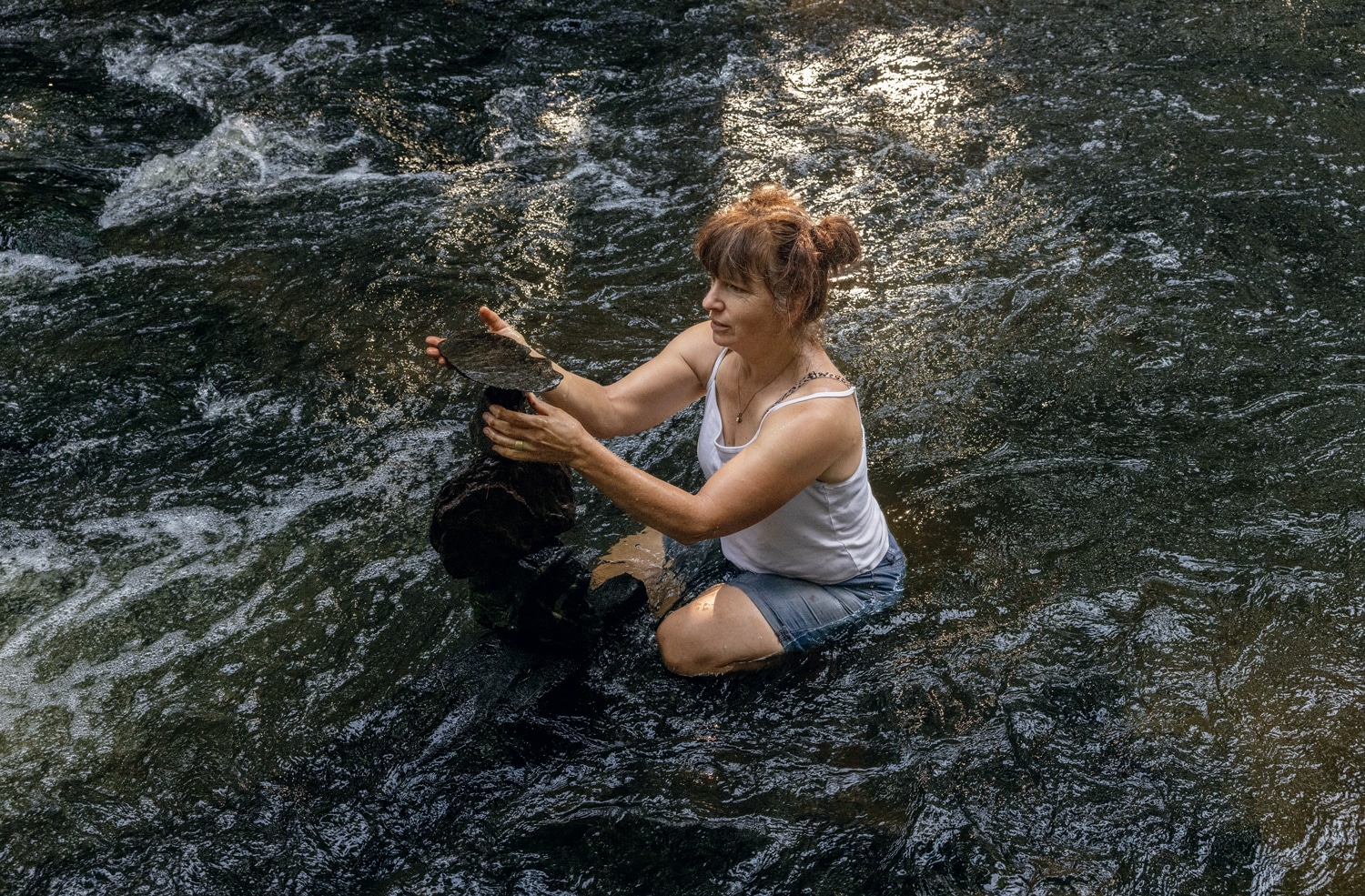
A tower of carefully balanced rocks takes shape in the hands of Thea Alvin as she kneels in the brook behind her home in Morrisville, Vermont.
Photo Credit : Greta RybusThe hobbit house burrows into a hillock in Morrisville, Vermont. Its round door is edged with a remarkable fringe of dark stone, the opening just tall enough to accommodate its creator, Thea Alvin, making it roughly 5 feet, 2 inches. Inside, the tiny domed space—the fruits of her workshop on how to build a root cellar—tunnels into the belly of the land. But this is not a story about height, or hobbits, or even strength, although for the record, this dark-haired, warmly funny stonemason artist can squat 460 pounds, she tells me without a hint of braggadocio.
This is a story about hands. What they can create, and how, and sometimes their ability to move literal mountains to make things of beauty. “My hands are so smart,” says Alvin. “They know what to do. They do it without me needing to direct them, spontaneously and independently. They do things I don’t have to anticipate or plan for.”
What they do is lift stone and place it in unlikely ways.
The Phoenix Helix spirals across Alvin’s front yard, a 100-foot-long-and-growing stony haven for chipmunks and the place where local teens come to have their yearbook photos taken. The continuous loops are like stone cartwheels, gravity-defying, awe-inspiring. The eye-catching helix follows the contours of Route 100, a roadway that is busy by Vermont standards—we are, after all, just nine miles from the slopes of Stowe. Which means that the casual Sunday driver, random visiting tourists, a New York Times reporter, and even Oprah’s people might be inclined to stop and explore Alvin’s sculpture park. Because she does call it a park, and there’s certainly much more to it: undulating walls that rise into Gothic arches or settle into circles; ponds edged in giant stone; a waterfall; a pizza oven modeled after the beehive-shaped trulli in southern Italy, where Alvin brings students to help repair those crumbing little structures. The soundtrack is provided by roosters and chickens, shaggy Angora goats, happy dogs, wind. “People stop on the side of the road all the time,” she says. “They tap on the door. Sometimes”—she pauses—“they come right into the house.”
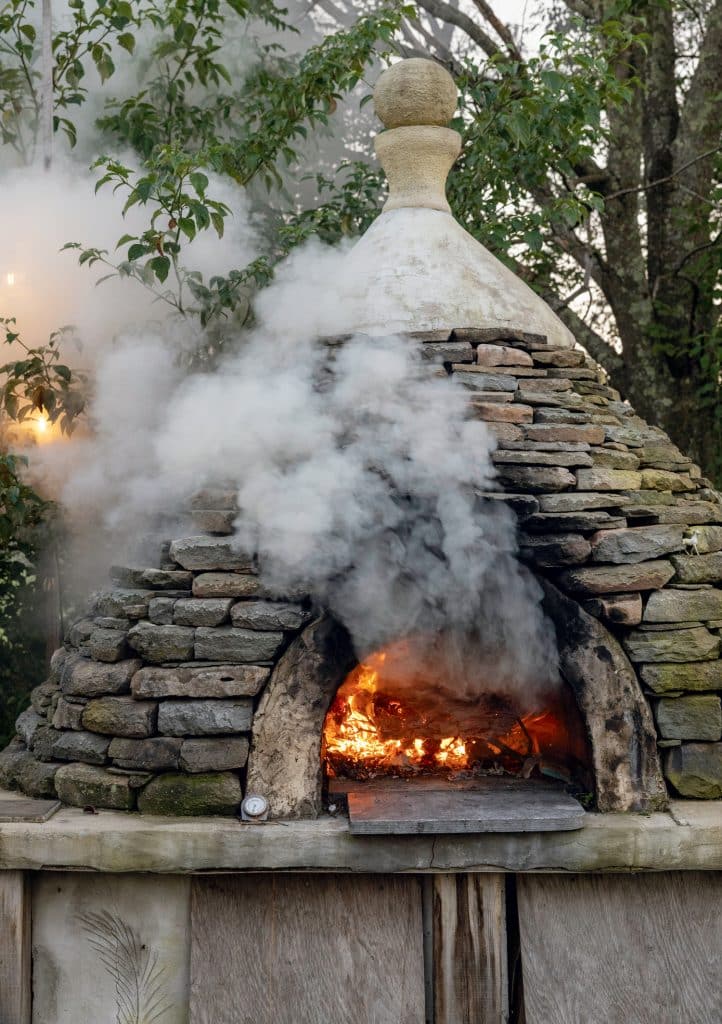
Photo Credit : Greta Rybus
The helix also tells a story with parallels to Alvin’s own life. It is a celebration of gravitas and astonishment, turns and spirals, explosions and joys. It is also tied to this wildly beautiful patch of land and its companionable buildings: an 1810 farmhouse, a wood-clad barn, a hobbit hole, a goat shed. She sometimes wonders whether the place is a vortex of energy, when she looks at her life, events, people, the creativity that seems to settle and swirl here.
“I grew up on Martha’s Vineyard,” she tells me, “and I ran away with a boy when I was 18. I married him, and we bought a camp in Wolcott, Vermont, and raised our kids out there in the wild. For 12 years we lived without running water, or electricity, and it was a hard, hard path.” But she credits that path with teaching her to work by “feel.”
“I lived for such a long time without electricity, so working in the dark has always been part of my way of doing things. What would it be like if I couldn’t see the stones? How would I manage them? Training my hands to see without my eyes has been a very important part of what I do.”
How to Make an Arch
Alvin learned the basics of stonecraft as a teenager, during the family’s yearly bouts of financial feast or famine, when her father would take on masonry jobs to pay the bills. Alvin, 16, was his helper. Later, she would build on that foundation, apprenticing with a stonemason in Stowe, and then taking on stone jobs for trade in Europe, with an organization called WWOOF (World Wide Opportunities on Organic Farms), gathering the skills that would ultimately pour into the massive sculptures, labyrinths, and stone “clocks” she is known for today.
When Alvin moved here 24 years ago, her stonework at the farm came alive almost from the start. She remembers sitting at the picnic table and crying, because “there was something about being able to buy this house. Some connection between me and the land. It feels like a sanctuary that allows me to express myself. An unconditional place where I can think out loud with my hands.”
We walk up a set of mossy stone stairs, past the hobbit door. “When I first came here, I wanted to make a sculpture on the highest ground,” she tells me. She points to a spot where old apple trees bend over a stone circle that looks out over the land like a benevolent eye. There’s a lot to take in, the cumulative work of decades: an apple orchard, a small vineyard of Maréchal Foch grapes, the blueberry patch, espaliered pear trees, beehives. There’s Aurora Pond, part of which Alvin built using an excavator. She topped it off with a waterfall tall enough to walk under, during that first year of Covid. “It was meant to be water security,” she says. “But look at that crop of tadpoles! It’s really frog security!”
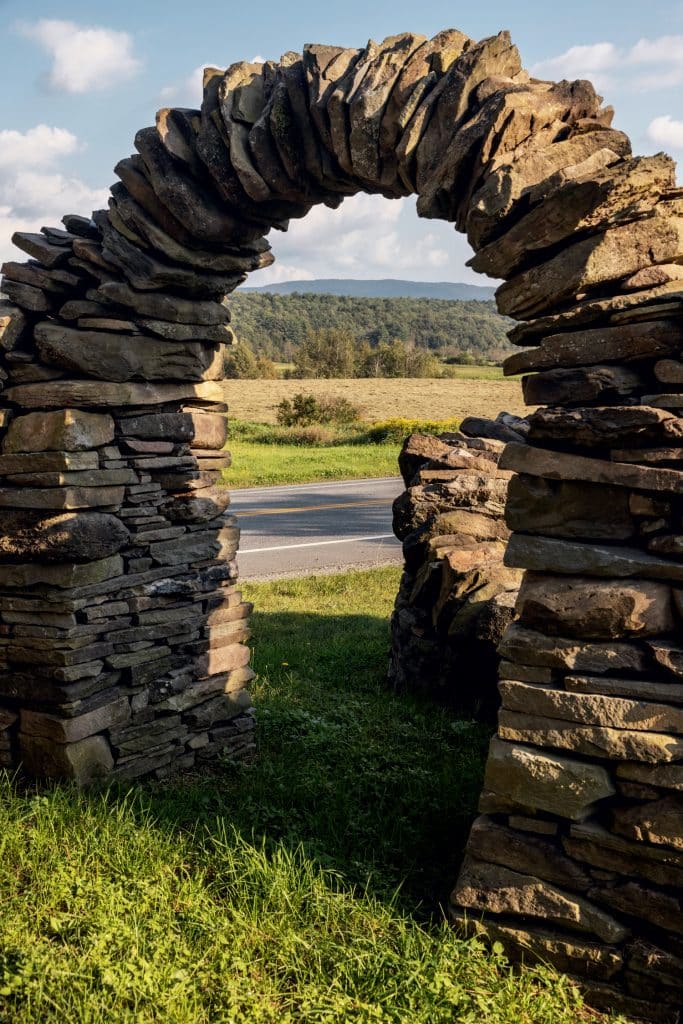
Photo Credit : Greta Rybus
Up here, surrounded by her handiwork, she explains how she taught herself to make an arch, because “anyone can study arch building, but I wanted to figure it out.” She began by stacking two columns of marble, wrapping her arms and legs around them, and guiding them together. The piles collapsed. But by summer’s end, Alvin had evolved a wooden arch to support the stones, and a system of wedges. That was the easy bit. “The challenging part is determining how big, and what shape, and how it looks—that’s where the art is.”
The tools of Alvin’s trade haven’t changed much since medieval days: a mason’s hammer (“brickie”) with a chisel on one end and a hammer on the other. “I don’t do a lot of what’s called ‘dressing’ the stone,” she says. “I don’t hammer it into submission. I like the rocks to have their natural edges. I don’t mind that a rock is rusty. The imperfection makes it feel comfortable, and it lets us explore it and accept ourselves with our own imperfections.”
All of her hammers have names, but her favorite is Karl, handmade in Barre, Vermont, a gift from a friend. And they’re spray-painted (a decidedly un-medieval touch), because “when they’re hot pink, they don’t get lost in the grass.” She tromps everywhere in her Crocs—footwear firmly planted in our times—so much so, that her feet are dotted with tan marks. Even so, as I relearn the differences between Gothic and Roman arches, it’s a little like time-traveling into the world of a medieval craftsperson.
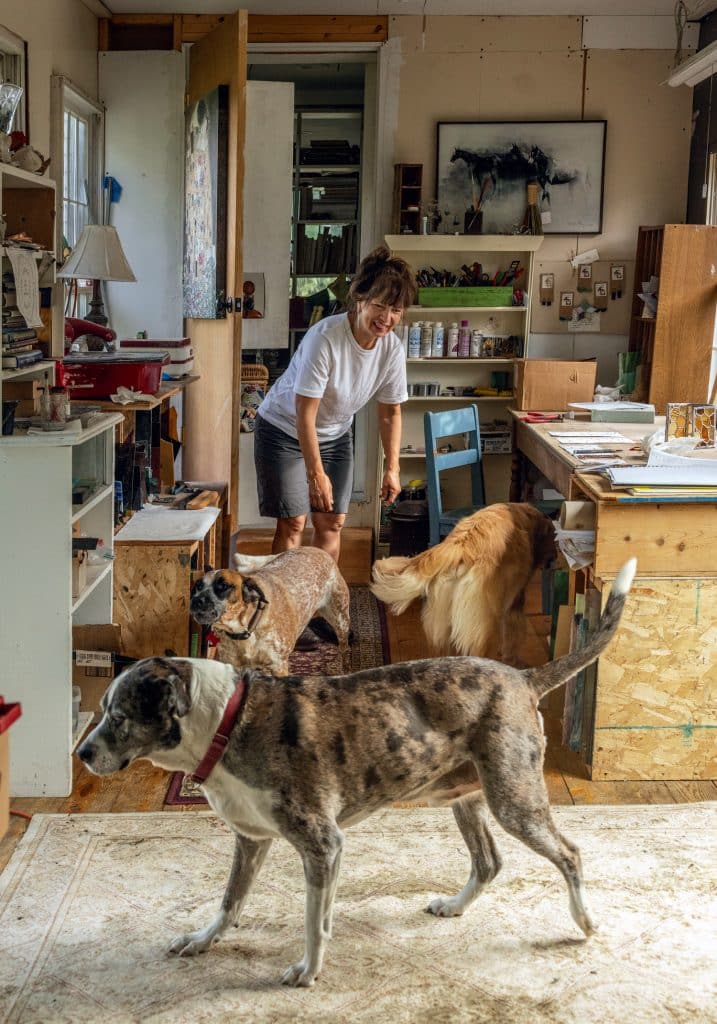
Photo Credit : Greta Rybus
“It would be pretty easy to look at me,” Alvin observes, “and make a judgment that would be 100 percent inaccurate. Unless someone looked at my hands, they would not guess what my capacity or skill set is.” She gives a quick smile. “And I really like that. I like that as a lesson for myself to not judge other people.” Her hands are rough and capable. Years of working with abrasive stone materials have worn her fingerprints off. But beyond that, her hands are never still.
As we wander, Alvin waters the goats, relocates a chicken, picks bugs off a vine, and gathers a few twigs to add to the “death tunnel,” woven from fallen tree branches, where she has buried her animals over the years: dogs and cats, chickens, goats, and pigs. These hands, she informs me, also do many other things. “I’ve been a tailor, a knitter, nursed quite a few sick animals. I’m a writer, I’ve done massage work, I prepare a lot of food. I tap trees, I make maple syrup in the spring, I paint, I plaster, I lay tile and brick. I can do any of the building things, and I know how to use all of the silverware on a fancy dining table.”
The rooster is absolutely screeching. Circling back, we pass by arching wooden forms, sunk in tall grasses behind the barn, waiting to shoulder their next load. “We’re kind of growing up together, too,” she tells me of this place. “And I’ve wanted, since the fire, to fix her and make her whole and beautiful.”
Fire on the Farm
The fire began at 3 a.m. on a December morning in 2017. It raged through the barn and studio, then jumped to the house, taking half of it. It killed goats and chickens, destroyed artwork, and left Alvin with such a heightened sense of hearing that she still wakes up at the slightest sound in the night. And then, not long after, she had to leave for southern Italy, to lead a workshop to help rebuild the trulli, in Puglia. “I feel like I have the most amazing luck and the worst luck,” she admits. “I feel super-lucky, but also like I’m a person with the widest span of paradox. The worst and best things happen at the very same time.”
When she came back from Italy, friends gathered from across the country to rebuild the barn—the post-and-beam raising, captured on film, is a stunning reminder of the goodness of people, who are not just raising up a building, but raising up someone they love. Slowly, over the next two years, she worked on rebuilding the house, too. “I wanted to make it a sculpture, not just a box, a standard house,” she says. She laid the brickwork where her woodstove sits; created a sliding chalkboard to cover the pantry doorway. An artist friend painted a garden on the new living room walls. She wanted a secret door, so she built one in the library, disguised as a bookshelf. The door swings open into her stained-glass studio—a craft she took up after the fire.
“I create something every day,” says Alvin. “And I teach a lot. But really, it’s by creating beautiful things every day that I’m able to combat what would otherwise be crushing depression with the things that I see: drought and poverty and homelessness and forest fire smoke. My mom has Alzheimer’s, and I care for her here. And watching her fade, and living through her fade—that’s incredible. I have to stay positive. I have to stay doing. Otherwise it would be overwhelming.” [Editor’s note: Thea Alvin’s mother passed away after this interview, in December 2023. “She was buried in a natural burial in my backyard,” Alvin says, “in a wicker basket and a shroud made from our goats, carried by her daughters and granddaughters.”]
She saves everything, knowing she will find a way to use it. Sticks from the lilacs, to make tunnels and treehouses. Old nails and shells. And stones, obviously. Because you never know when you’ll need more stones….
The Phoenix Helix
There’s a reason the dazzling spiral that sits in front of Alvin’s house is called the Phoenix Helix. It is not the first. The old one was destroyed two years ago in April by a street sweeper, when the driver fell asleep coming home from work. “It was 7 a.m. They were probably doing 65 miles an hour when they hit it,” she remembers. “It totaled the helix, it just exploded. Stone hit the house, hit the barn, went across the road.”
She heard it from the barn. Stones lay everywhere, shattered, unusable. “It didn’t really hit me until I came out and I was shooting video—I always have my camera—and I could see that it was destroyed. I burst into tears while filming. And I put that video on social media and the world just turned out, because the world knows me for the helix.”
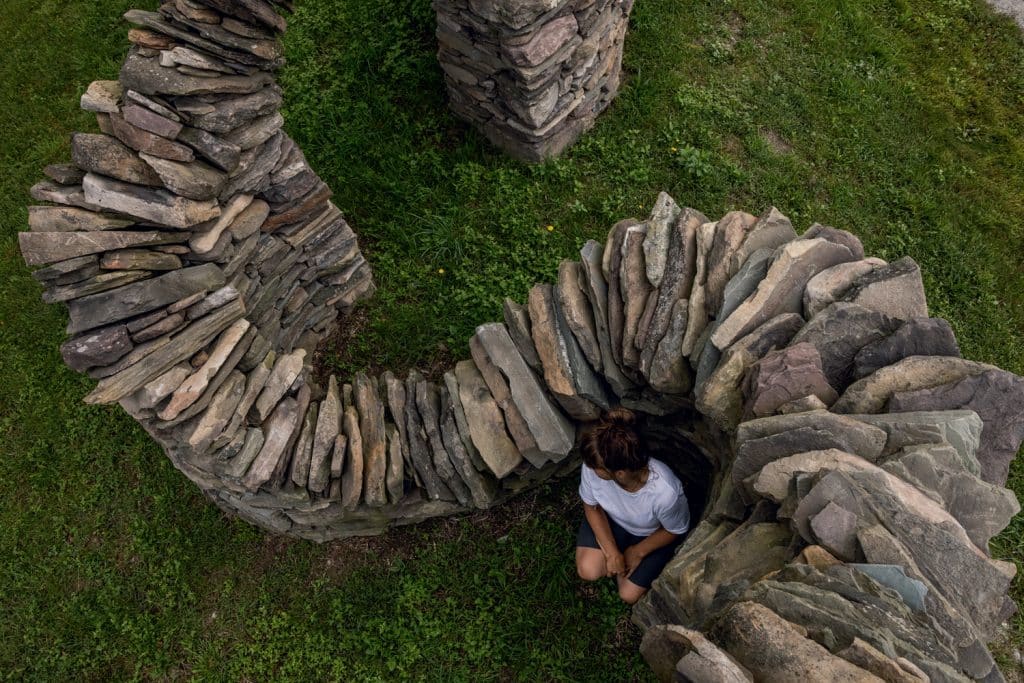
Photo Credit : Greta Rybus
Alvin’s sculpture park was already listed on the map for the Vermont Crafts Council’s Spring Open Studio Weekend, just a month away. “It was an emergency—I needed to show up for the state of Vermont,” she says, “but it was a very difficult technical structure.” Hundreds of people flocked to help, from masons and friends to novices, with Alvin directing every hand. In an astonishing three weeks, the helix was rebuilt, from new stone, on higher ground. The old, shattered stone was incorporated inside—at what is called the “heart” of the wall.
“Everyone asks, ‘How long did it take you to rebuild?’” She pauses, clearly bothered by a question that misses the point. “Sculpture is not like that—or painting or poetry. It’s the cumulative years that get you to the place where you are a master. Yes, it took three weeks of labor with a variety of people. And then the actual build was four days, with 20 people each day. But really”—she gives me a hard look—“it took 30 years of mastering my own craft.”
Going Too Fast, You Are
There is a signpost in Alvin’s backyard, not far from the pizza oven, with signs pointing off in all directions and the names and distances of every place in the world where Alvin has made sculptures, from West Tisbury, on Martha’s Vineyard, to Valle de Bravo, Mexico, to Suzhou, China. There have been multiple voyages to Domodossola, in northern Italy, to restore ancient stone houses through the Vermont design-build school Yestermorrow. And adventures restoring an old stone house in the Portuguese Azores, on the cliff face of a remote island called Flores.
She has created giant time sculptures around the United States. She calls them clocks—structures that operate on solstice, equinox, or birth/death dates. “I really appreciate time,” she says. “I feel like a tiny little sliver of it is given to me to pack some things into.” There’s In Good Time at Duke University in North Carolina; Time and Again at St. Michael’s College in Colchester, Vermont; Time Sweeps at Rowan University in New Jersey. And in Tennessee, there is a 1,000-foot-long labyrinth called Time for Love, marking the date a woman’s beloved husband died—on February 24, as the sun rises and angles through a window, it shines at heart level, above a bench in the center of the labyrinth.
“Someday,” Alvin remarks, “the romance and importance of that will be lost. And I love that the mystery of something as simple as one man’s birthday and death day will be completely lost. And people will wonder and ponder and try to figure out why some strange people built these strange things in this place. I love planting the seed of a mystery, because I love to solve the mysteries.”
Time goes hand in hand with stone. The ancient material is inherently contemplative, and so it seems completely obvious why there is a hand-painted cutout of Yoda attached to Alvin’s new barn’s rugged exterior, with the words proclaiming: “Going too fast, you are.” Stone, and everything about this place, is a reminder to slow down.
“When I’m tearing apart walls in Italy, I know that those people who built them 500 years ago were going through their own day-to-day things, just as I am,” Alvin says. “The stone carries the energy of those intentions, and you can feel the old hands of the old workers as they put them together. You can feel their thoughts. You can see it physically, when they were tired. It’s a story you can read.”
And it’s a story that brings us back to hands. When Alvin is working, she can look at the pile of stone, look at the wall, and the next rock is the only rock she sees. “It’s nonverbal,” she tells me. “And I pick it up, and I put it on the wall, and I turn around, and the next rock that goes on the wall is the only rock I see. If I come back with a rock that doesn’t fit in the hole, it goes in another spot. It doesn’t go back. It’s always forward.”
To see more of Thea Alvin’s creations and to learn about her workshops, go to myearthwork.com/thea-alvin.
Annie Graves
A New Hampshire native, Annie has been a writer and editor for over 25 years, while also composing music and writing young adult novels.
More by Annie Graves

